Please download PDF from above for the themes of the year & the following currencies.
Australian dollar // New Zealand dollar //Canadian dollar // Norwegian krone // Swedish Krona // Swiss franc // Czech koruna // Hungarian forint //Polish zloty // Romanian leu // Russian rouble // South African rand // Turkish lira // Indian rupee // Indonesian rupiah // Malaysian ringgit // Philippine peso //Singapore dollar // South Korean won // Taiwan dollar // Thai baht // Vietnamese dong // Argentine peso // Brazilian real // Chilean peso // Mexican peso // Crude oil // Saudi riyal // Egyptian pound
Annual Foreign Exchange Outlook
DEREK HALPENNY
Head of Research, Global Markets EMEA and International Securities
Global Markets Research
Global Markets Division for EMEA
E: derek.halpenny@uk.mufg.jp
LEE HARDMAN
Senior Currency Analyst
Global Markets Research
Global Markets Division for EMEA
E: lee.hardman@uk.mufg.jp
LIN LI
Head of Global Markets Research Asia
Global Markets Research
Global Markets Division for Asia
E: lin_li@hk.mufg.jp
MICHAEL WAN
Senior Currency Analyst
Global Markets Research
Global Markets Division for Asia
E: michael_wan@sg.mufg.jp
EHSAN KHOMAN
Head of Commodities, ESG and Emerging Markets Research – EMEA
DIFC Branch – Dubai
E: ehsan.khoman@ae.mufg.jp
CARLOS PEDROSO
Chief Economist
Banco MUFG Brasil S.A.
E: cpedroso@br.mufg.jp
MAURICIO NAKAHODO
Senior Economist
Banco MUFG Brasil S.A.
E: mnakahodo@br.mufg.jp
MUFG Bank, Ltd.
A member of MUFG, a global financial group
January 2024
2024 THEMES
In this the first edition of Foreign Exchange Outlook in 2024, as in previous years we have added an additional section – 2024 Themes – highlighting what we believe will be some of the key themes/risks for the financial markets this year. We have included five such themes for the year ahead and cover these in more depth. We hope you find some value in this additional section and welcome any feedback
USD SCOPE FOR DEPRECIATION GREATER IN H2
The US dollar weakened by 2.1% (DXY basis) in 2023 after an 8.2% gain in 2022 and a 5.4% gain in 2021. While the dollar weakened, the DXY index remained above the 100-level for the third consecutive year, the first time that has happened since 2002. We are now neutral to mildly bullish on the dollar in H1 but then expect a clearer weakening of the US dollar. The more neutral view initially in part reflects the sharp sell-off that took place in November and December (-5.2%) and the potential for the Fed to be more cautious on cutting rates relative to the second half of the year. In addition, the global growth backdrop remains challenging for a sustained dollar sell-off from here with Europe close to recession and China growth still subdued. Global growth conditions should gradually improve although geopolitical risks, less fiscal support and the potential for bouts of financial market volatility will act as headwinds. The Fed is likely to end 2024 cutting by more with more of those cuts coming in H2 as the US labour market slows.
EUR UPSIDE SCOPE
EUR followed a familiar pattern by rallying strongly into the end of last year. That could well reverse in the first quarter of this year given the weak economic backdrop in the euro-zone and weak global growth. The ECB is set to cut rates around the same time as the Fed limiting EUR/USD divergence trades but improving growth in Europe and a more active Fed in H2 will allow a clear EUR upside move to take hold.
JPY TO FINALLY RECOVER
The crux of yen underperformance over the last three years – higher global inflation and rates – is now reversing and assuming this is sustained, we expect the yen to strengthen this year. A rate hike from the BoJ is not a requirement for that view to be realised but a hike would reinforce yen strength. The recent earthquake in Japan may delay that hike but we maintain the end of ZIRP this year.
CNY STRENGTHENS ON A MORE BLANCED GROWTH AND IMPROVING SENTIMENT
The Chinese yuan weakened by 2.9% against the US dollar in 2023 amid heightened pessimism over the Chinese economy and Chinese assets. Despite a potential drag from external demand, the New Development Model for real estate sector should help to stabilize the housing sector and the overall economy in the year ahead. It supports our outlook for the CNY to strengthen against the US dollar in 2024.
Forecast rates against the US dollar - End-Q1 to End-Q4 2024
|
Spot close 29.12.23 |
Q1 2024 |
Q2 2024 |
Q3 2024 |
Q4 2024 |
|
|
JPY |
140.96 |
140.00 |
138.00 |
136.00 |
134.00 |
|
EUR |
1.1059 |
1.0800 |
1.1000 |
1.1200 |
1.1400 |
|
GBP |
1.2739 |
1.2630 |
1.2790 |
1.2870 |
1.2950 |
|
CNY |
7.1012 |
7.0500 |
7.0000 |
6.9000 |
6.8000 |
|
AUD |
0.6818 |
0.6600 |
0.6700 |
0.6800 |
0.7100 |
|
NZD |
0.6332 |
0.6100 |
0.6200 |
0.6200 |
0.6400 |
|
CAD |
1.3208 |
1.3500 |
1.3400 |
1.3200 |
1.3000 |
|
NOK |
10.137 |
10.556 |
10.273 |
9.911 |
9.5610 |
|
SEK |
10.053 |
10.556 |
10.273 |
10.000 |
9.6490 |
|
CHF |
0.8415 |
0.8520 |
0.8360 |
0.8390 |
0.8330 |
|
|
|
|
|
|
|
|
CZK |
22.339 |
22.870 |
22.640 |
22.320 |
22.110 |
|
HUF |
345.94 |
351.90 |
350.00 |
348.20 |
346.50 |
|
PLN |
3.9294 |
4.0280 |
4.0000 |
3.9730 |
3.9040 |
|
RON |
4.4992 |
4.6200 |
4.5640 |
4.5000 |
4.4390 |
|
RUB |
90.045 |
91.700 |
92.820 |
94.880 |
96.900 |
|
ZAR |
18.288 |
18.800 |
19.000 |
19.200 |
19.000 |
|
TRY |
29.560 |
31.500 |
34.000 |
36.000 |
38.000 |
|
|
|
|
|
|
|
|
INR |
83.230 |
83.300 |
83.000 |
82.500 |
82.000 |
|
IDR |
15399 |
15350 |
15200 |
15100 |
15000 |
|
MYR |
4.6350 |
4.6200 |
4.5900 |
4.5300 |
4.4700 |
|
PHP |
55.495 |
55.400 |
55.300 |
55.200 |
55.000 |
|
SGD |
1.3197 |
1.3250 |
1.3100 |
1.3000 |
1.2900 |
|
KRW |
1291.0 |
1285.0 |
1275.0 |
1255.0 |
1235.0 |
|
TWD |
30.996 |
31.200 |
30.900 |
30.650 |
30.300 |
|
THB |
34.370 |
34.400 |
34.200 |
33.750 |
33.300 |
|
VND |
24268 |
24200 |
24150 |
24100 |
24000 |
|
|
|
|
|
|
|
|
ARS |
808.50 |
1100.00 |
1300.00 |
1500.0 |
1600.0 |
|
BRL |
4.8524 |
4.8900 |
4.9100 |
4.9300 |
4.9500 |
|
CLP |
873.38 |
880.00 |
890.00 |
895.00 |
900.00 |
|
MXN |
16.905 |
17.300 |
17.400 |
17.500 |
17.600 |
|
|
|||||
|
Brent |
77.42 |
81.00 |
80.00 |
86.00 |
89.00 |
|
NYMEX |
71.78 |
76.00 |
75.00 |
81.00 |
84.00 |
|
SAR |
3.7500 |
3.7500 |
3.7500 |
3.7500 |
3.7500 |
|
EGP |
30.900 |
31.500 |
32.300 |
34.100 |
35.000 |
Notes: All FX rates are expressed as units of currency per US dollar bar EUR, GBP, AUD and NZD which are expressed as dollars per unit of currency. Data source spot close; Bloomberg closing rate as of 4:30pm London time, except VND which is local onshore closing rate.
2024
Theme 1:
Global challenges and the US dollar in 2024
- Fed rate cuts as inflation declines further should mean a weaker USD
- But weak global growth & other challenges will curtail USD selling
- USD upside risks in H1 should shift to downside risks in H2
Theme 2:
US Outlook: Getting Back in Sync?
- Our base case is a “bumpy landing” (mild recession) sometime in 2024
- Soft-landings are rare: stars need to align between fiscal, Fed and banks
- Base-case for the Fed is 175bps of cuts in 2024 (starting in March 2024)
- Alternative-view could see a much quicker pace of cuts (total of 275bps)
Theme 3:
The New Development Model for China’s Property Sector
- Structural and cyclical pressures likely persist in China’s property sector, but there is room for further policy adjustments on both the demand and supply side.
- We expect a moderate improvement in property sales, but commodity real estate activities likely remain weak in general. A more noticeable improvement would happen on non-commodity real estate activities.
- The New Development Model for the real estate sector and the Three Major Projects (including the Construction of Affordable Housing, Urban Villages, and the Construction of Public Infrastructure for "Both Leisure and Emergency Use) will become the main drivers for a stable real estate sector in 2024.
Theme 4:
Energy markets – calling pause to our supercycle thesis but underinvestment’s revenge will bite
- We classify the year 2024 for commodities as one of balance with bullish (cyclical) forces of a fading monetary policy drag and receding recession fears alongside (structural) influences of ongoing backwardation (supply tightness) offsetting bearish “higher for longer” interest rate dynamics
- Beyond these 2024 forces, the long-term structural challenges miring commodities (decarbonisation, deglobalisation, redistributive demand-led policies and structural underinvestment) remain unresolved – thus, we call pause to our supercycle thesis until macro headwinds are behind us
Theme 5:
Political risk to become more important FX market driver in 2024
- There is a busy schedule of global elections which means that political risk could become a more important driver of FX market performance in 2024, and at the very least could trigger bouts of higher volatility.
- While most elections will mostly have mainly as domestic impact, the US Presidential election at the end of this year could have more far reaching implications that could affect FX market performance.
- The USD staged strong rally at the end of 2016 after Donald Trump became President. Will history be repeated?
US dollar
|
Spot close 29.12.23 |
Q1 2024 |
Q2 2024 |
Q3 2024 |
Q4 2024 |
|
|
USD/JPY |
140.96 |
140.00 |
138.00 |
136.00 |
134.00 |
|
EUR/USD |
1.1059 |
1.0800 |
1.1000 |
1.1200 |
1.1400 |
|
Range |
Range |
Range |
Range |
||
|
USD/JPY |
134.00-150.00 |
132.00-148.00 |
130.00-146.00 |
128.00-144.00 |
|
|
EUR/USD |
1.0600-1.1400 |
1.0700-1.1600 |
1.0800-1.1700 |
1.0900-1.1900 |
MARKET UPDATE
In 2023 the US dollar weakened against the euro in terms of London closing rates from 1.0683 to 1.1059. The intra-day high was 1.1276 in July and the intra-day low was 1.0448 in October. However, the dollar strengthened against the yen also from 131.86 to 140.96. The intra-day high was 151.91 in November and the intra-day low was 127.23 in January. The FOMC raised the federal funds rate by a further 100bps to 5.25%-5.50%. The pace of QT adjusted by the Fed from September 2022 to USD 95.0bn (USD 60bn UST bonds & USD 35bn MBS) was maintained throughout 2023 although the regional banking sector turmoil saw the balance sheet expand to allow access to liquidity. Still, over the whole of the year, the Fed balance sheet declined by USD 838bn to USD 7,713bn.
OUTLOOK
The US dollar (DXY basis) weakened by 2.1% in 2023, which followed two years of gains of 8.2% (2022) and 6.4% (2021). Still, 2023 was the third consecutive year in which the DXY index closed above the 100-level – the first time that has happened since 2002. The US dollar performance in 2023 can be summarised in three parts – no clear trend in H1 followed by a sharp appreciation period between July and October and then the reversal of that strength from October to year-end. Like in 2022, last year was all about inflation and the weakness of the dollar since October marked the realisation that inflation in the US was falling nearly as fast as it had previously increased. The annual core CPI rate accelerated from 4.0% in September 2021 to the peak of 6.6% in 12mths. It fell back to 4.0% in October 2023, a 13mth period. There remains a way to go to get back to the 2.0% Fed target but the 6mth annualised core PCE inflation rate fell to 1.9% in November, highlighting the increased risks of a faster return to price stability than originally expected.
In a year in which the Fed will be cutting its key policy rate, there is certainly scope for the dollar to depreciate. However, we also need to be mindful of the 2024 outlook in the context of the sharp sell-off that took place in Nov/Dec last year. Driven by a 100bp drop in the 10yr UST bond yield, the US dollar weakened by 6%. A rate cut by the Fed in March remains 70% priced and weak economic data is required soon to validate a cut by then The labour market is weakening but moderately and possibly not to the extent to ease monetary policy as soon as March. But a continued gradual softening of the labour market may allow a rate cut by then and it remains a close call between March and May. Given this is mostly priced and given the ECB will likely cut around the same time, we doubt this will prompt any notable dollar sell-off. The global growth backdrop is also an impediment to dollar selling.
There is scope for the US dollar to rebound over the near-term given the extent of rate cuts from the Fed now priced in the rates market. Even if the Fed cuts in March, the tone from the Fed is likely to signal caution but as the economy weakens the Fed will more actively cut in H2, helping accelerate the pace of US dollar depreciation.
INTEREST RATE OUTLOOK
|
Interest Rate Close |
Q1 2024 |
Q2 2024 |
Q3 2024 |
Q4 2024 |
|
|
Policy Rate |
5.33% |
5.13% |
4.63% |
4.13% |
3.63% |
|
3-Month T-Bill |
5.38% |
5.00% |
4.50% |
4.00% |
3.50% |
|
10-Year Yield |
4.00% |
4.25% |
3.88% |
3.38% |
3.75% |
* Interest rate assumptions incorporated into MUFG foreign exchange forecasts.
In the recently published US 2024 Outlook Report (click here) we recently tweaked our Fed rate path view. We now expect 175bps in cuts (previous range was 150-200bps in cuts for 2024 since mid-summer). To make it straight forward, this assumes 25bp cuts at every meeting starting in March. It’s a version of “measured” Fed policy in reverse. This would take the Fed Funds median range to 3.625%, which would still be 75-100bps more restrictive than the long-run neutral rate. Slow and steady rate reductions would allow the Fed time to assess the economy’s reaction. It would also allow the Fed to keep QT in place into late 2024. That said, in the latest FOMC minutes, the Fed is preparing the public on when it will end its balance-sheet roll-off. Its possible that the tapering of QT takes place closer to the first cut (or at the same time) and would see QT phase out by 4Q24. The March cut is the most contentious and challenged piece of our Fed call. However, as we have seen in the last few months narratives can change as can the data and market performance. If there are no flare-ups before March, the first cut may come instead in either May or June, if they skip March. (George Goncalves)
FED CUTS PRICED IN AS OF 05/01/2024
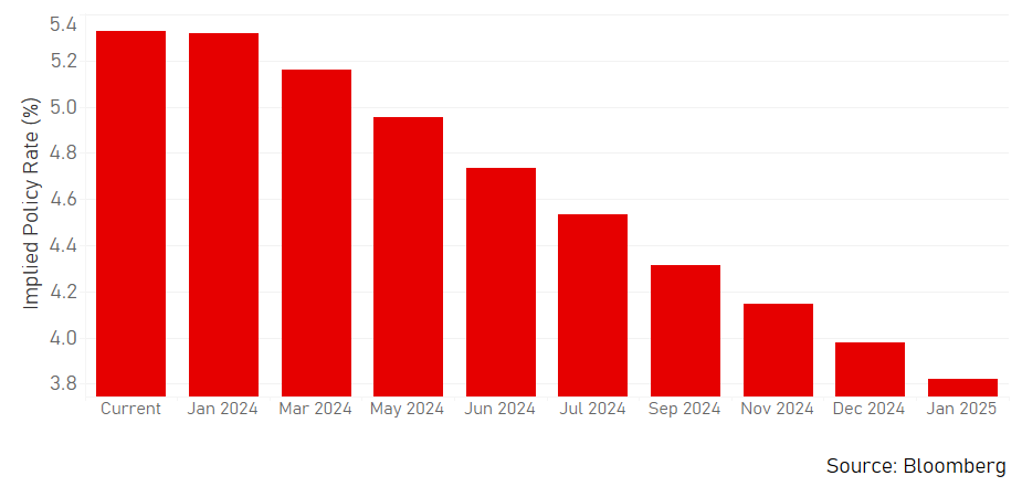
FEDERAL RESERVE BANKS TOTAL ASSETS
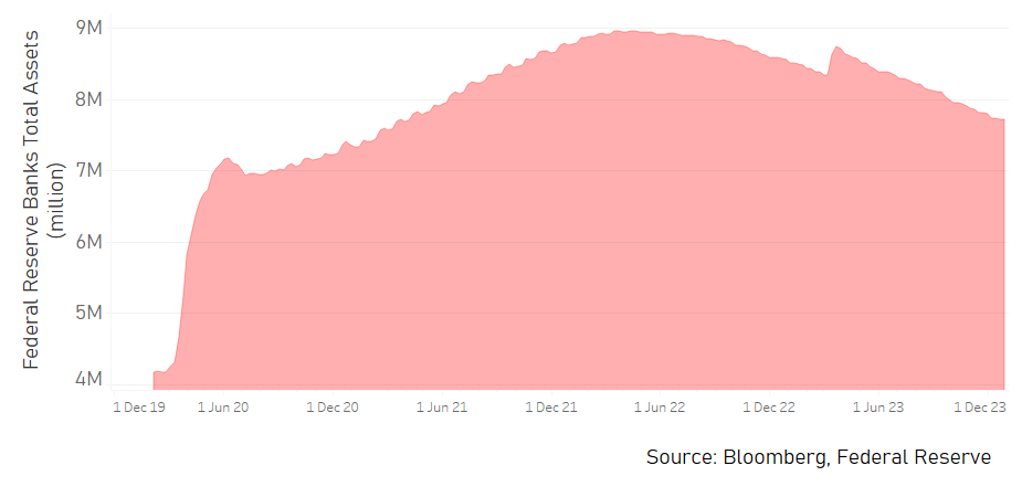
Japanese yen
|
Spot close 29.12.23 |
Q1 2024 |
Q2 2024 |
Q3 2024 |
Q4 2024 |
|
|
USD/JPY |
140.96 |
140.00 |
138.00 |
136.00 |
134.00 |
|
EUR/JPY |
155.89 |
151.20 |
151.80 |
152.30 |
152.80 |
|
Range |
Range |
Range |
Range |
||
|
USD/JPY |
134.00-150.00 |
132.00-148.00 |
130.00-146.00 |
128.00-144.00 |
|
|
EUR/JPY |
148.00-163.00 |
146.00-161.00 |
144.00-159.00 |
142.00-157.00 |
MARKET UPDATE
In 2023 the yen weakened notably against the US dollar in terms of London closing rates, from 131.86 to 140.96. The intra-day high was 151.91 in November and the intra-day low was 127.23 in January. In addition, the yen weakened against the euro from 140.87 to 155.89. The intra-day high was 164.30 in November and the intra-day low was 137.39 in January. In July the BoJ altered its policy stance through Yield Curve Control by widening the +/-50bps band around zero percent for 10yr JGB yields by 50bps to +/-100bps. The BoJ made a further change to YCC in October by softening the upper band 10yr yield level of 1.00% to a reference rate rather than a limit. The loosening of the YCC framework was accompanied by still notable outright purchases of JGBs by the BoJ.
OUTLOOK
The yen ended 2023 as the worst performing G10 currency, weakening by 7% versus the US dollar. The performance would have been a lot worse but for a 10 big figure drop in USD/JPY in Nov/Dec. The primary driver of this was the plunge in US yields as rate cut expectations surged. On occasions the yen strengthened on speculation of a shift in BoJ policy as well although this was secondary to US developments. But BoJ policy deliberations will certainly be a focus for the markets this year and we maintain that the BoJ will hike its key policy rate by 20bps to +0.10% this year – in April with January no longer plausible given recent BoJ communication and given the terrible earthquake that struck Japan on New Year’s Day. That likely means the BoJ turns more cautious near-term on when to hike.
However, Governor Ueda made clear in an NHK TV interview prior to the earthquake that the BoJ could act without having wage negotiation data available while on Christmas Day Governor Ueda highlighted some positive aspects for households and corporations from higher interest rates. Deputy Governor Himino also made a speech in early December on the merits of higher rates. It is clear to us that the BoJ is on a communications drive to prepare the markets for a hike in its key policy rate.
The yen was the worst performing G10 currency in 2021 and 2023 and the second worst in 2022. This sustained period of JPY weakness has coincided with global inflation rising along with global yields. This has now started to go into reverse and we see this reversal of the global inflation surge and the decline in yields as a backdrop that will ultimately prompt a further recovery of the yen. The energy price shock was hugely negative for Japan’s external trade position and this is now correcting and removing one additional negative yen factor. The government is also implementing further fiscal stimulus in an attempt to boost support for the government and this is likely to add to inflationary pressures and hence validate the BoJ view that inflation is becoming more sustained. Positioning remains short yen after a long period of attractive returns due to carry but this is set to end and position liquidation will likely reinforce the move stronger.
INTEREST RATE OUTLOOK
|
Interest Rate Close |
Q1 2024 |
Q2 2024 |
Q3 2024 |
Q4 2024 |
|
|
Policy Rate |
-0.10% |
-0.10% |
0.10% |
0.10% |
0.10% |
|
3-Month Bill |
-0.20% |
-0.10% |
0.10% |
0.10% |
0.10% |
|
10-Year Yield |
0.62% |
0.80% |
0.90% |
0.80% |
1.00% |
* Interest rate assumptions incorporated into MUFG foreign exchange forecasts.
The BoJ in its actions last year have made clear of their desire to dilute the Yield Curve Control framework and we see this culminating with the full removal of YCC, and while we do not see this now happening in January, a full removal possibly by April still seems plausible. The surge in inflation globally and in Japan points to less need for a fixed rate regime and risks creating renewed distortions in the JGB market. The removal of YCC will likely coincide with the removal of NIRP (and ZIRP) and we expect when the BoJ does decide to hike that it will hike by 20bps, taking the key policy rate to +0.10%. The tragic earthquake on New Year’s Day does point to increased caution for a time in order to allow the BoJ to assess the economic impact although at this point it seems the overall macro impact will be small. Given the disinflation trend globally, Japan will likely see its inflation move in the same direction as elsewhere but for Japan stronger wage growth and evidence of a slower decline in inflation would help encourage a policy shift. So we expect the 10-year JGB yield to drift lower in line with global yields although the decline is expected to be smaller.
USD/JPY VS. US 2YR YIELD
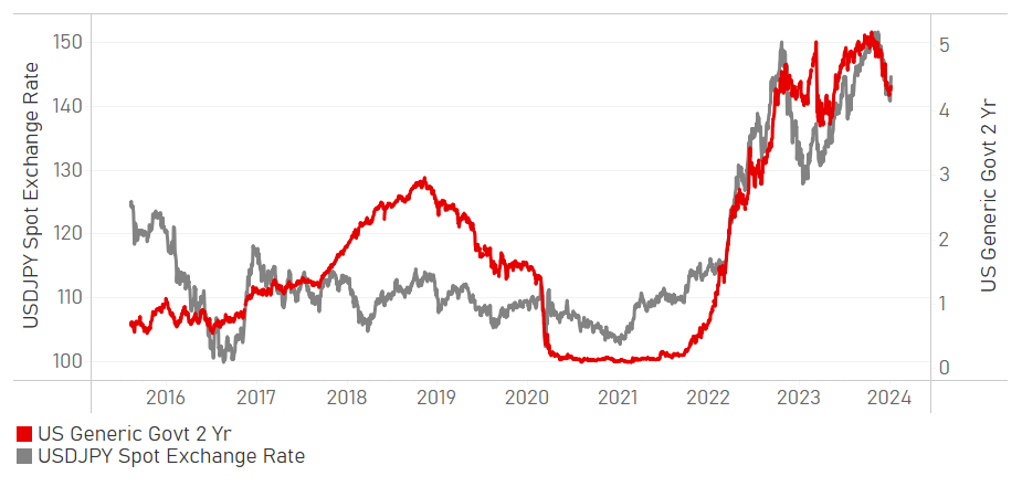
JAPAN TRADE BALANCE
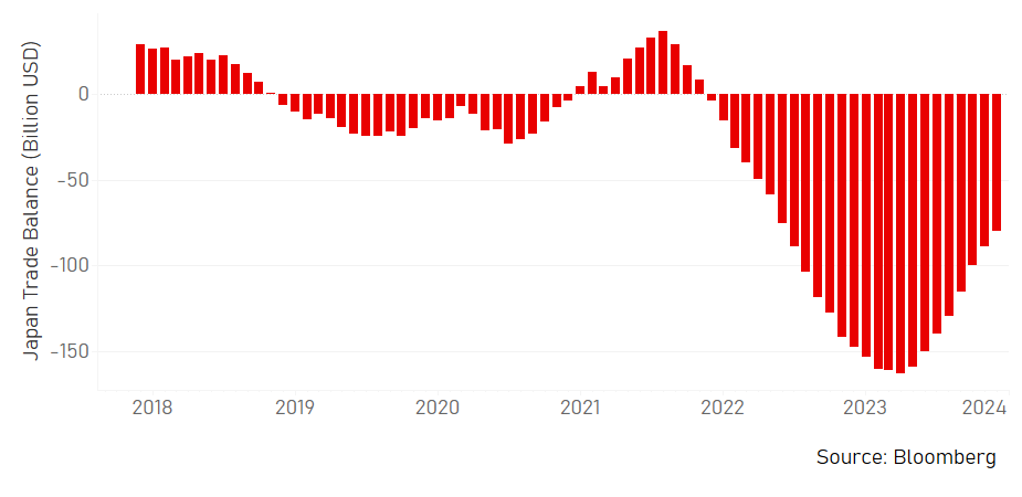
Euro
|
Spot close 29.12.23 |
Q1 2024 |
Q2 2024 |
Q3 2024 |
Q4 2024 |
|
|
EUR/USD |
1.1059 |
1.0800 |
1.1000 |
1.1200 |
1.1400 |
|
EUR/JPY |
155.89 |
151.20 |
151.80 |
152.30 |
152.80 |
|
Range |
Range |
Range |
Range |
||
|
EUR/USD |
1.0600-1.1400 |
1.0700-1.1600 |
1.0800-1.1700 |
1.0900-1.1900 |
|
|
EUR/JPY |
148.00-163.00 |
146.00-161.00 |
144.00-159.00 |
142.00-157.00 |
MARKET UPDATE
In 2023 the euro strengthened against the US dollar in terms of London closing rates from 1.0683 to 1.1059. The intra-day high was 1.1276 in July and the intra-day low was 1.0448 in October. Following the aggressive policy tightening in 2022 when the ECB hiked the key deposit rate by 250bps, the ECB hiked by a further 200bps in 2023 to take the key policy rate to 4.00%. The ECB also continued with its policy of QT through the reduction of assets on its balance sheet. TLTROs were further reduced with now only just under EUR 500bn held compared to a peak of EUR 2.2trn. As of 22nd December, the APP had declined by EUR 179bn in 2023 with the PEPP remaining roughly unchanged at EUR 1.67trn. Full reinvestments under PEPP is set to end in 2024 as was indicated at the ECB in December.
OUTLOOK
The EUR/USD rate traded in rough 8-big figure trading range in 2023, the narrowest range since 2019 and highlights the resilience of the euro in the face of near recessionary conditions in the euro-zone. EUR/USD fell from the intra-day high of the year to the low within a 3mth period from July to October as US yields increased relative to core Europe. That move then nearly fully reversed as Fed rate cut expectations intensified. However, the relatively small FX trading range did highlight the degree of synchronised expectations on monetary policy. The Fed and the ECB are expected to commence cutting around the same time – between March and May while the total amount of monetary easing this year is relatively similar – 150-160bps. The inflation backdrop in the euro-zone is just as favourable as in the US with core inflation falling faster than expected. It has taken nine months for core CPI to fall from the peak of 5.7% to the latest 3.x% in December. It took eleven months to cover the same extent on the way higher. Sticky core inflation is not really in evidence.
We believe the ECB is being too pessimistic in its inflation forecasts and by March we may see a further shifting lower of projections that allows for the ECB to commence cutting rates, possibly before the Fed. The ECB slashed its headline CPI forecast for this year from 3.2% to 2.7% but was more moderate with core inflation, lowering the forecast from 2.9% to 2.7%. Surprisingly, given these changes, the ECB raised its 2025 core CPI projection 0.1ppt to 2.3%. Modestly tighter fiscal policy in Germany and euro-zone growth remaining below trend at just 0.5% points to downside risks to inflation. Wage pressures are also receding with the Indeed Wage Tracker showing wage growth slowing further from here.
The moderating labour market in the US and the likely caution from the Fed as it commences its easing cycle in either March or May means the timing of rate cuts relative to the ECB will be reasonably synchronised which leaves us broadly neutral on the EUR/USD outlook in H1. EUR/USD in these circumstances can correct the end-2023 rally before turning higher more sustainably later this year as the Fed easing gets underway and global growth prospects turn a little more favourable.
INTEREST RATE OUTLOOK
|
Interest Rate Close |
Q1 2024 |
Q2 2024 |
Q3 2024 |
Q4 2024 |
|
|
Policy Rate |
4.00% |
4.00% |
3.50% |
3.00% |
2.75% |
|
3-Month Bill |
3.79% |
3.80% |
3.20% |
2.70% |
2.50% |
|
10-Year Yield |
2.12% |
2.20% |
1.90% |
1.70% |
1.90% |
* Interest rate assumptions incorporated into MUFG foreign exchange forecasts.
The 10-year German bund yield ended 2023 lower, by 55bps at 2.02%. However, the 10-year yield hit close to 3.00% in October before falling sharply into the end of the year. Again, like in 2022, 2023 was dominated by inflation and for much of the year the fears over sticky underlying inflation kept yields supported as the ECB continued to tighten. But there was a dramatic shift in expectations as inflation started to come in much lower than expected. We now have good evidence to suggest inflation is falling as fast as it increased, which will open up the scope for ECB easing. We have pencilled in the first rate cut from the ECB in April, in or around the same time as the Fed (March or May). Lower inflation, monetary easing and weak economic activity will likely keep yields moving lower but the extent in which yields can decline from here is now more limited given the sharp drop in yields into the end of last year. Also growth should improve in the second half of the year as global manufacturing picks up and falling inflation helps to support consumer spending. QT by the ECB will also pick-up as PEPP maturities roll off, again limiting the downside for yields.
EURO AREA CPI FORECASTS, %
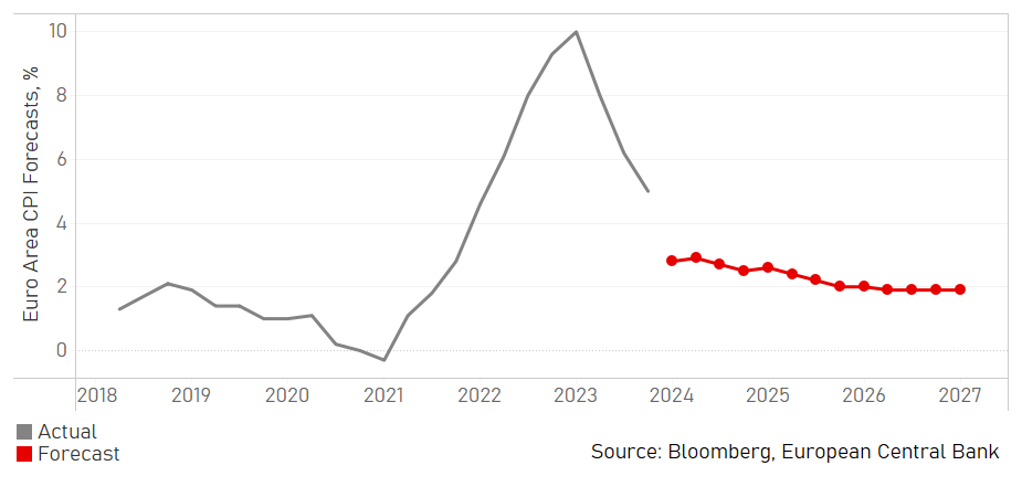
EURO AREA HICP KEY COMPONENTS YOY, %
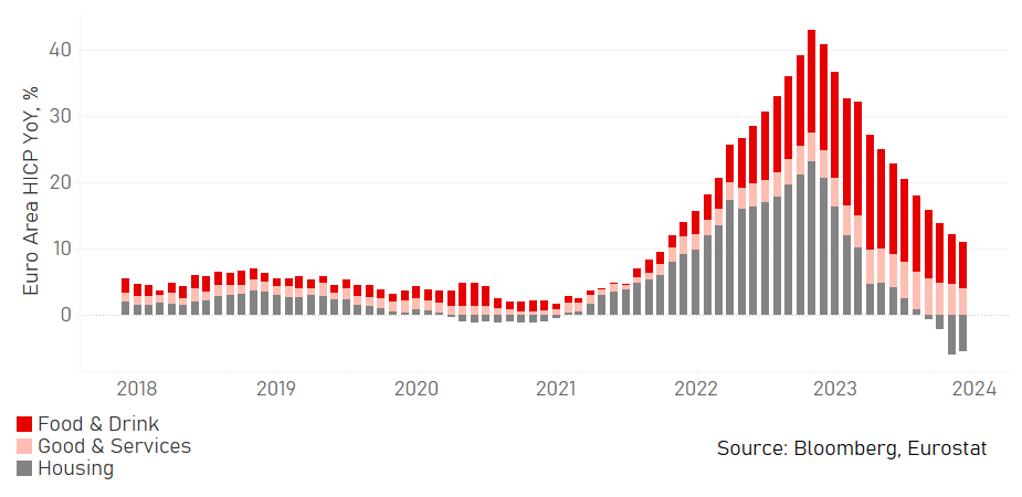
Pound Sterling
|
Spot close 29.12.23 |
Q1 2024 |
Q2 2024 |
Q3 2024 |
Q4 2024 |
|
|
EUR/GBP |
0.8681 |
0.8550 |
0.8600 |
0.8700 |
0.8800 |
|
GBP/USD |
1.2739 |
1.2630 |
1.2790 |
1.2870 |
1.2950 |
|
GBP/JPY |
179.57 |
176.80 |
176.50 |
175.10 |
173.60 |
|
Range |
Range |
Range |
Range |
||
|
GBP/USD |
1.2350-1.3300 |
1.2400-1.3400 |
1.2450-1.3500 |
1.2500-1.3600 |
MARKET UPDATE
In 2023 the pound strengthened against the US dollar in terms of London closing rates from 1.2047 to 1.2739. The intra-day high was 1.3142 in July and the intra-day low was 1.1804 in March. In addition, the pound strengthened against the euro from 0.8868 to 0.8681. The intra-day high was 0.8979 in February, and the intra-day low was 0.8493 in August. The MPC after raising the Bank Rate aggressively, by 325bps to 3.50% in 2022 raised the key rate a further 175bps to 5.25% last year. After commencing outright sales of Gilts in November 2022, the BoE continued to run down its holdings of Gilts and from October 2023 the BoE’s pace of reduction (both from maturities and outright sales) increased from GBP 80bn per year to GBP 100bn. As a result of QT, the BoE’s balance sheet declined by GBP 128bn to GBP 801bn as of 13th December.
OUTLOOK
The pound was the 2nd best performing G10 currency in 2023 with only the Swiss franc outperforming. We believe carry certainly played a role here with the BoE being one of the more active central banks in hiking rates – only the Fed and the RBNZ have higher policy rates, and then only just. Furthermore, for much of last year expectations of rate cuts by the BoE were less than by the Fed and the ECB. Market expectations continue to indicate a later start to rate cuts by the BoE which has helped provide the pound with support. The performance though also reflected the depressed levels the pound started 2023 at and the stickiness of inflation in the UK relative to the US and Europe helped fuel demand for the pound. The BoE trade-weighted GBP Index advanced by over 8% between March and July as the 3mth SONIA future implied yield hit 6.50%. That yield then fell 200bps as UK inflation began to drop more sharply, dragging the pound weaker from earlier highs.
The BoE policy stance remains more hawkish than the ECB or the Fed. The latest MPC statement maintains a bias to tighten. We view this as inappropriate and see risks now that the BoE has over-tightened. As mentioned in Theme 1 based on market OIS rate expectations and inflation consensus for Q4, the real policy rate of the BoE is set to jump substantially, which to us is an indication of the risk of the BoE over-tightening. It implies to us that there is scope for the BoE to cut by even more than currently priced. The economy is set to remain weak but the return of inflation to the target level (possibly before elsewhere) will help lift consumer confidence. A general election later this year will likely delay a pick-up in business investment. We expect the Labour Party to win and a period of policy stability should follow either later this year (if the election is in May/June) or in 2025.
We expect a pivot from the BoE to a much more dovish stance as inflation continues to fall. Initial GBP strength should then give way with GBP underperforming other G10 currencies versus the dollar. This should mean EUR/GBP and GBP/USD both drift higher in H2.
INTEREST RATE OUTLOOK
|
Interest Rate Close |
Q1 2024 |
Q2 2024 |
Q3 2024 |
Q4 2024 |
|
|
Policy Rate |
5.25% |
5.25% |
5.00% |
4.50% |
3.75% |
|
1-Year Yield |
5.29% |
5.15% |
4.70% |
4.20% |
3.40% |
|
10-Year Yield |
3.73% |
3.80% |
3.40% |
3.20% |
3.40% |
* Interest rate assumptions incorporated into MUFG foreign exchange forecasts.
UK 10yr Gilt yields spent much of the first eight months of the year trending higher as stickier inflation in the UK than in the euro-zone and the US prompted investors to price in more aggressive rate hikes from the BoE. From October though, the 10-year Gilt yield fell sharply as inflation started to drop notably. Over 2023 as a whole, the 10-year Gilt yield fell 13bps to close at 3.54%. In 2024, the stronger disinflation trend that commenced in Q4 is likely to continue which should help anchor 10-year yields. Based on current gas and electricity prices, the OFGEM price set in April could result in the annual CPI rate falling to or below the 2.0% target from the current level of 3.9%. Real GDP growth is currently on the brink of recording a technical recession and while growth should improve gradually as 2024 unfolds, the scope for monetary easing will become more apparent resulting in a pivot from the MPC, which continues to communicate a bias to tighten policy. Given the 10-year Gilt yield dropped by 100bps since the start of November last year, the scope for a further sharp drop has diminished but we still expect a gradual drop in yields from here this year.
UK CPI FORECASTS, %
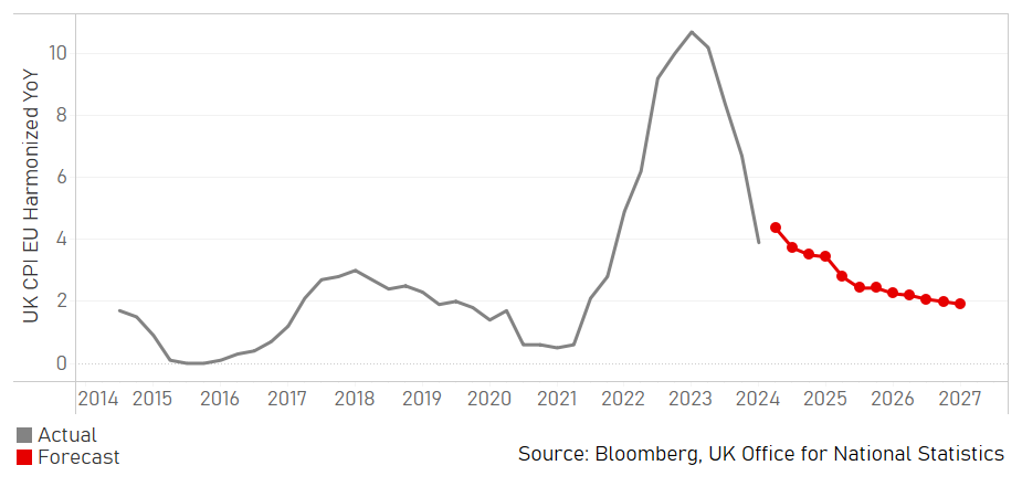
GBP/JPY CARRY RETURN
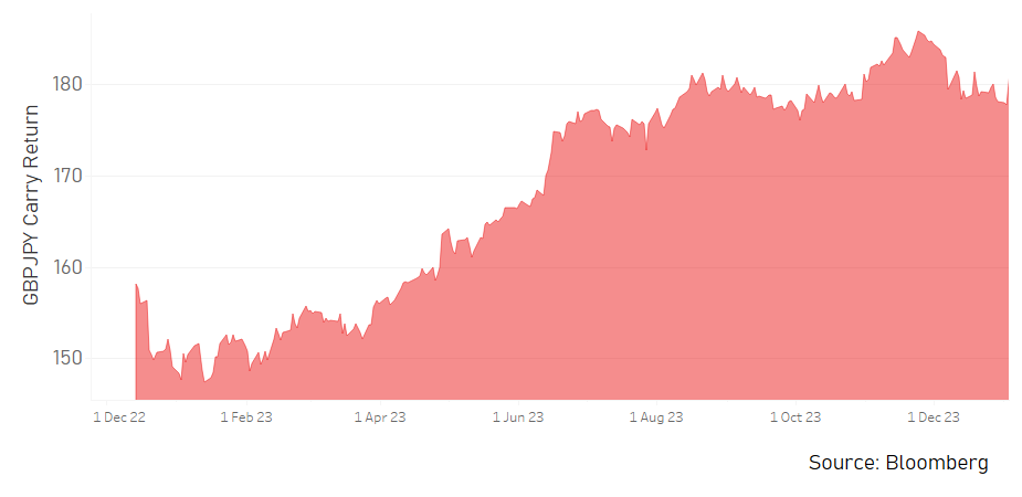
Chinese renminbi
|
Spot close 29.12.23 |
Q1 2024 |
Q2 2024 |
Q3 2024 |
Q4 2024 |
|
|
USD/CNY |
7.1012 |
7.0500 |
7.0000 |
6.9000 |
6.8000 |
|
USD/HKD |
7.8104 |
7.8000 |
7.7900 |
7.7900 |
7.7800 |
|
Range |
Range |
Range |
Range |
||
|
USD/CNY |
6.8500-7.2500 |
6.7500-7.1500 |
6.6500-7.0500 |
6.6000-7.0000 |
|
|
USD/HKD |
7.7700-7.8400 |
7.7700-7.8400 |
7.7600-7.8300 |
7.7500-7.8200 |
MARKET UPDATE
In 2023, the Chinese yuan weakened by 2.9% against the US dollar, with USD/CNY moving from 6.8971 to 7.1012. Last year, the PBOC cut the RRR twice with one 25bps cut on 27th March and on 15th September, cut the 1-year medium-term lending facility rate twice (from 2.75% to 2.5%) and cut the 1-year loan prime rate twice (from 3.65% to 3.45%), while trimming the 5-year LPR by 10bps to 4.2%.
OUTLOOK
Chinese economic activities remained weak lately. November indicators showed China’s industrial production and retail sales continued to recover, while the real estate industry is not yet stabilized and deflationary risks remain. The December China NBS manufacturing PMI fell to 49 from November’s 49.4 and below Bloomberg consensus expectation of a 49.6, with new order and new export order declining to 48.7 and 45.8 while production and business expectation increased to a stronger 55.9. China NBS non-manufacturing PMI rose to 50.4 in December from November’s 50.2 (below Bloomberg consensus expectation of a 50.5), mainly driven by the construction sector while the service sector remained in contraction. Amid continuing weakness in major sectors, in first 11 months of 2023, China’s utilized foreign capital shrank 10%yoy to RMB1.04 trillion and November’s amount was the lowest monthly figure since Feb 2020. China’s benchmark CSI 300 Index fell by 11.4% to 3431 in 2023. Foreign investors were seen a net buying of US$8 bn on China’s equities market through Northbound Stock Connect, much lower than 2022’s net buying of US$13 bn and the lowest level since 2016.
In December’s Politburo meeting and annual Central Economic Work Conference last year, Chinese government stated to consolidate the coordination and cooperation of fiscal, monetary, employment, industrial, regional, technological and environmental policies. Moreover, Chinese authorities vowed to accelerate the new development model for real estate industry and support private sector. In December, Beijing and Shanghai announced measurements to ease their home buying policies, and more cities are expected to follow. Furthermore, commercial banks cut deposit rates for multiple products in late December, following two rounds of cuts in June and September. We expect more favourable policies to be announced to help lift China’s economy and improve market sentiment towards China’s assets. We forecast a gradual GDP growth of 4.8%yoy in 2024, slightly slower than 2023’s 5.2%yoy, but a more balanced growth with China’s property sector’s stabilizing in 2024.
China is likely to set a “around 5%” growth target for 2024, and rollout more policies to elevate confidence
In this March’s National People’s Congress meeting, China is likely to set an “around 5%” growth target for 2024, same as last year. All in all, we see CNY appreciating against the dollar in 2024, supported by a stabilized housing market, narrower negative yield spread between China and US, and an improvement in investor sentiment and a repairment of consumer confidence. Thus, we expect USD/CNY to decline to 7.05 by Q1 2024 and 6.80 by Q4 2024.
INTEREST RATE OUTLOOK
|
Interest Rate Close |
Q1 2024 |
Q2 2024 |
Q3 2024 |
Q4 2024 |
|
|
Loan Prime Rate 1Y |
3.45% |
3.35% |
3.25% |
3.25% |
3.25% |
|
MLF 1Y |
2.50% |
2.50% |
2.40% |
2.30% |
2.30% |
|
7-Day Repo Rate |
1.80% |
1.80% |
1.70% |
1.60% |
1.60% |
|
10-Year Yield |
2.56% |
2.70% |
2.68% |
2.65% |
2.65% |
* Interest rate assumptions incorporated into MUFG foreign exchange forecasts.
Negative inflation fuels deflation concerns and pushed up real interest rate. China’s benchmark 10-year government bond yield fell 28bps to 2.557% in 2023, implying market confidence towards China’s economy remained pessimistic. In December’s Central Economic Work Conference last year, the Chinese government pledged to implement a proactive fiscal policy and a flexible, appropriate, precise and effective monetary policy. On 4th January, Finance Minister Lan Fo’an said in an interview that China would expand fiscal spending this year, reflecting a stronger fiscal support would happen to bolster demand. In late December, Chinese banks cut deposit rates for the third time in 2023 and were bigger than those in June and September. After that, the PBOC on its Q4 quarterly meeting vowed to reinforce existing monetary policy and push up consumer prices. We expect these adjustments to help consumer spending and provide more room for the PBOC to lower funding cost to boost investment activity. We expect a total 20~30bps of policy rate cuts in 2024.
CHINA’S STOCK MARKET SLID 11.4% IN 2023, BUT IMPROVEMENT IN DEC
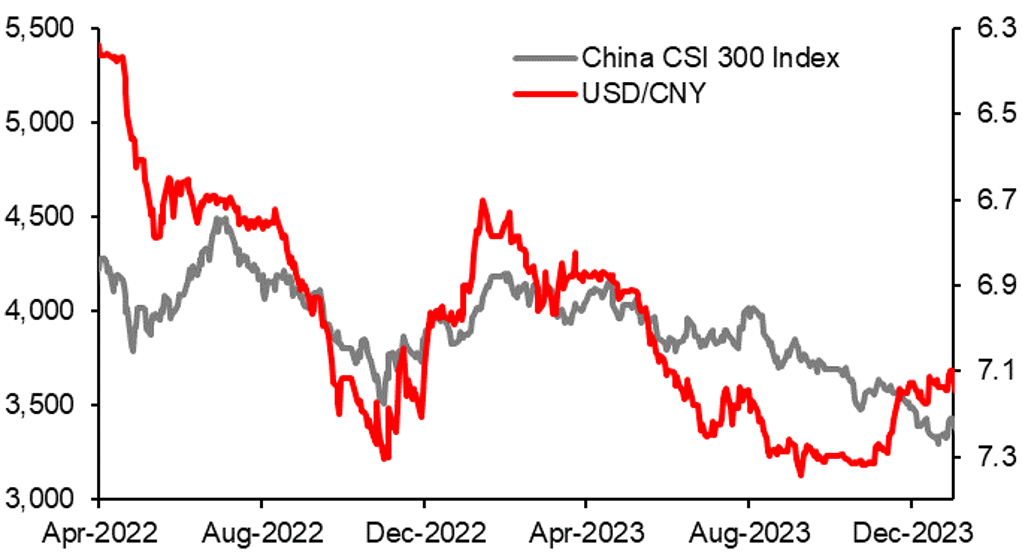
Source: Bloomberg, MUFG GMR
BOTH NEW ORDER AND NEW EXPORT ORDER FURTHER DROPPED
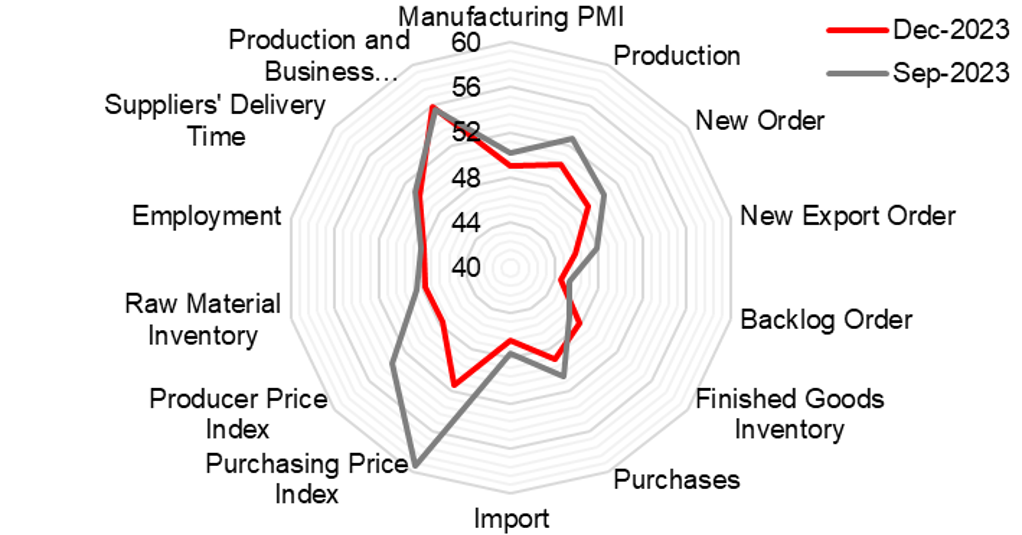
Source: CEIC, MUFG GMR



